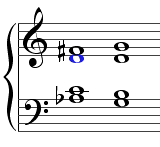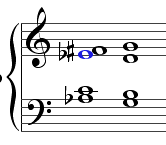
Predominant
Encyclopedia


Music theory
Music theory is the study of how music works. It examines the language and notation of music. It seeks to identify patterns and structures in composers' techniques across or within genres, styles, or historical periods...
, a predominant chord (also pre-dominant) is any chord
Chord (music)
A chord in music is any harmonic set of two–three or more notes that is heard as if sounding simultaneously. These need not actually be played together: arpeggios and broken chords may for many practical and theoretical purposes be understood as chords...
which normally resolves to
Resolution (music)
Resolution in western tonal music theory is the move of a note or chord from dissonance to a consonance .Dissonance, resolution, and suspense can be used to create musical interest...
a dominant
Dominant (music)
In music, the dominant is the fifth scale degree of the diatonic scale, called "dominant" because it is next in importance to the tonic,and a dominant chord is any chord built upon that pitch, using the notes of the same diatonic scale...
chord. Examples of predominant chords are the subdominant
Subdominant
In music, the subdominant is the technical name for the fourth tonal degree of the diatonic scale. It is so called because it is the same distance "below" the tonic as the dominant is above the tonic - in other words, the tonic is the dominant of the subdominant. It is also the note immediately...
(IV), supertonic
Supertonic
In music or music theory, the supertonic is the second degree or note of a diatonic scale, one step above the tonic. In music theory, the supertonic chord is symbolized by the Roman numeral ii in a major scale, indicating that the chord is a minor chord , or ii in a natural minor scale, indicating...
(ii), Neapolitan sixth and German sixth. Other examples are the submediant
Submediant
In music, the submediant is the sixth scale degree of the diatonic scale, the 'lower mediant' halfway between the tonic and the subdominant or 'lower dominant'...
(vi), secondary dominant
Secondary dominant
Secondary dominant is an analytical label for a specific harmonic device, prevalent in the tonal idiom of Western music beginning in the common practice period...
(V/V), iv and ii°. The predominant harmonic function
Diatonic function
In tonal music theory, a diatonic function is the specific, recognized role of each of the 7 notes and their chords in relation to the diatonic key...
is part of the fundamental harmonic progression
Chord progression
A chord progression is a series of musical chords, or chord changes that "aims for a definite goal" of establishing a tonality founded on a key, root or tonic chord. In other words, the succession of root relationships...
of many classical works.

Dominant (music)
In music, the dominant is the fifth scale degree of the diatonic scale, called "dominant" because it is next in importance to the tonic,and a dominant chord is any chord built upon that pitch, using the notes of the same diatonic scale...
in a musical composition. Usually, the dominant preparation is derived from a circle of fifths
Circle of fifths
In music theory, the circle of fifths shows the relationships among the 12 tones of the chromatic scale, their corresponding key signatures, and the associated major and minor keys...
progression. The most common dominant preparation chords are the supertonic
Supertonic
In music or music theory, the supertonic is the second degree or note of a diatonic scale, one step above the tonic. In music theory, the supertonic chord is symbolized by the Roman numeral ii in a major scale, indicating that the chord is a minor chord , or ii in a natural minor scale, indicating...
, the subdominant
Subdominant
In music, the subdominant is the technical name for the fourth tonal degree of the diatonic scale. It is so called because it is the same distance "below" the tonic as the dominant is above the tonic - in other words, the tonic is the dominant of the subdominant. It is also the note immediately...
, the V7/V
Secondary dominant
Secondary dominant is an analytical label for a specific harmonic device, prevalent in the tonal idiom of Western music beginning in the common practice period...
, the Neapolitan chord
Neapolitan chord
In music theory, a Neapolitan chord is a major chord built on the lowered second scale degree. It most commonly occurs in first inversion so that it is notated either as II6 or N6 and normally referred to as a Neapolitan sixth chord...
(N6 or II6), and the augmented sixth chord
Augmented sixth chord
In music theory, an augmented sixth chord contains the interval of an augmented sixth above its "root" or bass tone . This chord has its origins in the Renaissance, further developed in the Baroque, and became a distinctive part of the musical style of the Classical and Romantic periods.-Resolution...
s (e.g., Fr+6).
In sonata form
Sonata form
Sonata form is a large-scale musical structure used widely since the middle of the 18th century . While it is typically used in the first movement of multi-movement pieces, it is sometimes used in subsequent movements as well—particularly the final movement...
, the dominant preparation is in the development, immediately preceding the recapitulation
Recapitulation (music)
In music theory, the recapitulation is one of the sections of a movement written in sonata form. The recapitulation occurs after the movement's development section, and typically presents once more the musical themes from the movement's exposition...
. Ludwig van Beethoven
Ludwig van Beethoven
Ludwig van Beethoven was a German composer and pianist. A crucial figure in the transition between the Classical and Romantic eras in Western art music, he remains one of the most famous and influential composers of all time.Born in Bonn, then the capital of the Electorate of Cologne and part of...
's sonata-form
Sonata form
Sonata form is a large-scale musical structure used widely since the middle of the 18th century . While it is typically used in the first movement of multi-movement pieces, it is sometimes used in subsequent movements as well—particularly the final movement...
works generally have extensive dominant preparation — for example, in the first movement of the Sonata Pathétique
Piano Sonata No. 8 (Beethoven)
Ludwig van Beethoven's Piano Sonata No. 8 in C minor, Op. 13, commonly known as Sonata Pathétique, was written in 1798 when the composer was 27 years old, and was published in 1799. Beethoven dedicated the work to his friend Prince Karl von Lichnowsky...
, the dominant preparation lasts for 29 measures (mm. 169-197).

